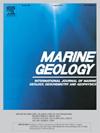Discovery of the world's largest cliff-top boulder: Initial insights and numerical simulation of its transport on a 30–40 m high cliff on Tongatapu (Tonga)
IF 2.2
3区 地球科学
Q2 GEOSCIENCES, MULTIDISCIPLINARY
引用次数: 0
Abstract
This study provides the first scientific investigation of the Maka Lahi boulder, a large limestone cliff-top boulder, measuring 14 × 12 × 6.7 m and weighing approximately 1180 t, located 200 m inland at 39 m elevation on the southern coast of Tongatapu, Tonga. The boulder is one of the largest known wave-transported boulders worldwide. Fieldwork conducted in 2024 revealed its presence, geomorphic setting, and karstification features. Utilizing numerical modelling, we established that wave heights of approximately 50 m and periods of 90 s were required to transport the boulder from its cliff-edge origin, suggesting that its emplacement likely resulted from a landslide-triggered tsunami event. U/Th dating of flowstone on the surface is indicative of a minimum age of 6891 cal yr BP and contributes critical evidence of a significant early Holocene tsunami event in Tonga. Notably, this represents the earliest known Holocene tsunami in the Pacific, offering new insights into the long-term history of extreme wave events in the region. This research strengthens the understanding of megaclast transport mechanisms and their implications for coastal hazard assessments in tsunami-prone regions.
发现世界上最大的悬崖顶部巨石:在汤加30-40米高的悬崖上对其运输的初步见解和数值模拟
这项研究首次对Maka Lahi巨石进行了科学调查,这是一块巨大的石灰岩悬崖顶部巨石,尺寸为14 × 12 × 6.7米,重约1180吨,位于汤加汤加塔普南部海岸,海拔39米,内陆200米。这块巨石是世界上已知的最大的波浪搬运巨石之一。2024年的野外考察揭示了它的存在、地貌环境和岩溶特征。利用数值模拟,我们确定需要大约50米的波浪高度和90秒的周期才能将巨石从悬崖边缘的起源移动,这表明它的就位可能是由山体滑坡引发的海啸事件造成的。表面流石测年表明其最小年龄为6891 calyr BP,为汤加早全新世重大海啸事件提供了重要证据。值得注意的是,这代表了太平洋已知最早的全新世海啸,为该地区极端海浪事件的长期历史提供了新的见解。这项研究加强了对巨碎岩运输机制的理解及其对海啸易发地区沿海灾害评估的影响。
本文章由计算机程序翻译,如有差异,请以英文原文为准。
求助全文
约1分钟内获得全文
求助全文
来源期刊

Marine Geology
地学-地球科学综合
CiteScore
6.10
自引率
6.90%
发文量
175
审稿时长
21.9 weeks
期刊介绍:
Marine Geology is the premier international journal on marine geological processes in the broadest sense. We seek papers that are comprehensive, interdisciplinary and synthetic that will be lasting contributions to the field. Although most papers are based on regional studies, they must demonstrate new findings of international significance. We accept papers on subjects as diverse as seafloor hydrothermal systems, beach dynamics, early diagenesis, microbiological studies in sediments, palaeoclimate studies and geophysical studies of the seabed. We encourage papers that address emerging new fields, for example the influence of anthropogenic processes on coastal/marine geology and coastal/marine geoarchaeology. We insist that the papers are concerned with the marine realm and that they deal with geology: with rocks, sediments, and physical and chemical processes affecting them. Papers should address scientific hypotheses: highly descriptive data compilations or papers that deal only with marine management and risk assessment should be submitted to other journals. Papers on laboratory or modelling studies must demonstrate direct relevance to marine processes or deposits. The primary criteria for acceptance of papers is that the science is of high quality, novel, significant, and of broad international interest.
 求助内容:
求助内容: 应助结果提醒方式:
应助结果提醒方式:


